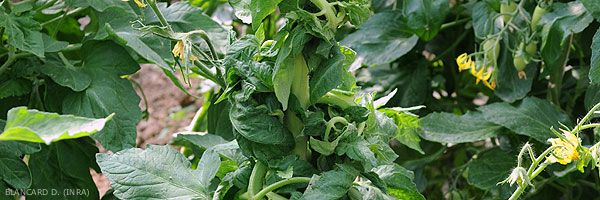
Genetic abnormalities of the foliage
Several genetic mutations s or chromosomal aberrations (in the formation of chromosomes or their number) ( genetic abnormalities ) are responsible for changes in color and / or shape of the leaflets and in tomato leaves. With regard to leaf deformations, we can observe more or less "crumpled" leaflets, rolled up in relation to their axis or their plane; the tissues are thicker (figure 1). It should also be noted that the plants are often sterile (hence their name of “ sterile mutants ”) and that they quite frequently take on a bushy appearance. Several types of sterile plants can appear in culture. The most common type occurs as plants with reduced, distorted, and often coiled leaves, bearing much less long hairs on stems, leaves, and flower stalks than normal plants. Another type manifests as more vigorous plants, with darker foliage and larger leaflets; the stem and the tissues are often thicker (this type is called " bull plants " by the Anglo-Saxons).
These "chimeras" must be considered as curiosities without consequences for the culture. In fact, in the majority of cases, a very small proportion of plants are affected. They are classified under physiological diseases; they should not be confused with viral diseases or phytotoxicities and they are in no way transmissible to surrounding plants.
Other genetic abnormalities affecting chlorophyll production in tomatoes are described in the chapter Leaf coloration abnormalities . Several genetic disorders affect the fruits of the tomato; they are largely detailed in the chapter devoted to this body.
These "chimeras" must be considered as curiosities without consequences for the culture. In fact, in the majority of cases, a very small proportion of plants are affected. They are classified under physiological diseases; they should not be confused with viral diseases or phytotoxicities and they are in no way transmissible to surrounding plants.
Other genetic abnormalities affecting chlorophyll production in tomatoes are described in the chapter Leaf coloration abnormalities . Several genetic disorders affect the fruits of the tomato; they are largely detailed in the chapter devoted to this body.





